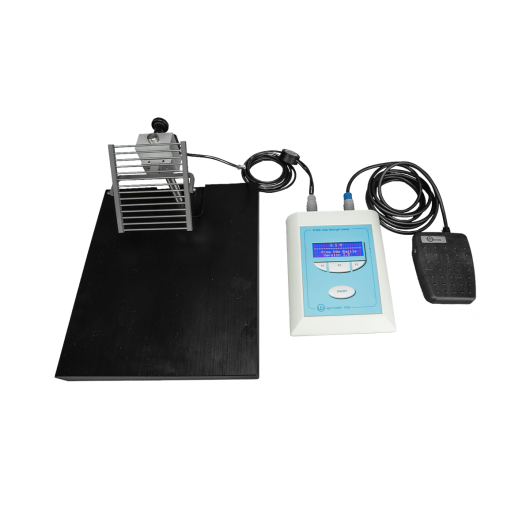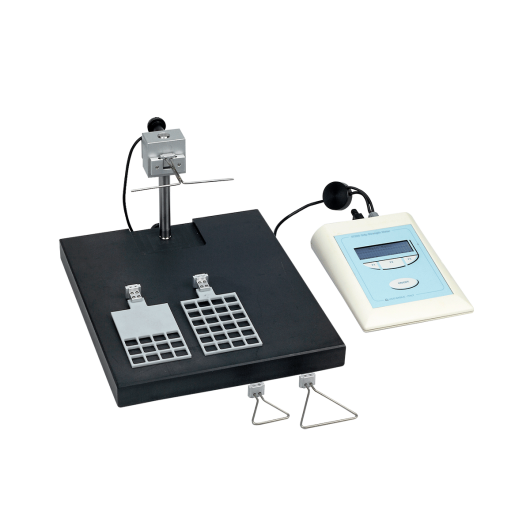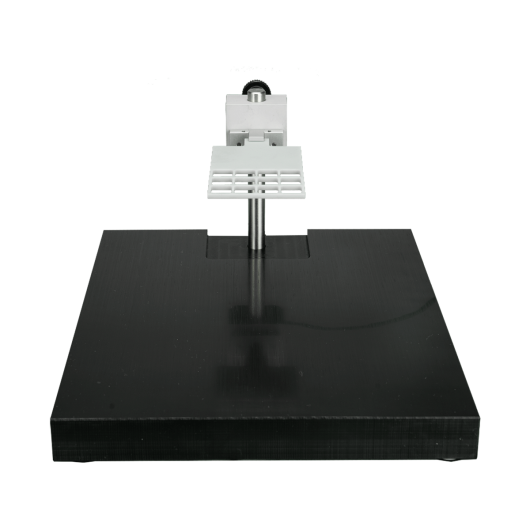






Grip strength meter for mice and rats
The Grip Strength Meter automatically measures grip strength of forelimb, hind limb, or all four limbs, in rats and mice as they instinctively resist backwards movement. For assessing the effects of substances (drugs, toxins, muscle relaxants) and conditions (disease, ageing, neural damage) on muscle strength. Integrated sensor and amplifier for precision measurements and consistency. Stand-alone (battery powered) or connect to PC software supplied. Includes stainless-steel T-shaped bar, 2 stainless-steel trapeze bars, a plastic grasping grid, a plastic grasping grid partly blind and a stainless-steel orientable grid (40,3g). Easy-to-use control unit with display, internal memory and quick data transfer (.csv).
- To stop an involuntary backward movement, the animal instinctively grabs the grasping bar when pulled backwards by the tail.
- Neuromuscular function studies in rodents are achievable with the GSM determining the grip peak-pull force
Automated detection, standalone or PC-based
- Automatically stores and displays the peak pull-force (peak tension) achieved by the limbs before the animal loses grip.
- The grip strength meter has a reliable and automated detection of the animal response thanks to its peak detector.
- The slope feature is useful to verify if the desired force has been applied with consistency.
- The quality control software tool shows the applied pulling force, the desired target force rate and the peak detection in real time.
- A force sensor and a peak amplifier have been integrated for high-precision measurements with a grip strength meter. The maximum applicable force is 1’500g with a resolution of 0.1g.
- The device can be used stand-alone or can be connected to a PC via the USB port to monitor the experiment and record the data.
- Control unit with internal memory to view and save data. Quick data transfer in .csv or .txt format for data analysis.
- There is no need of manual calibration since the instrument has an auto-calibration feature before running any trial.
- The grip strength meter is provided with a stainless-steel T-shaped bar, 2 stainless-steel trapeze bars, a plastic grasping grid, a plastic grasping grid partly blind and a stainless-steel orientable grid (40,3g)
- The DCA software for signal monitoring is included in with the GSM.
Features&benefits of Grip strenght meter from Ugo Basile
- Force-rate monitoring tools (software and LCD display): it helps the researcher to apply the force with a consistent rate by the PC software and/or the LCD display.
- Automatic peak detector: the peak of pull-force is automatically stored in the grip strength meter memory
- 6 different grasping tools included: unique device for both mice and rats. Included in the box: stainless-steel T-shaped bar, 2 stainless-steel trapeze bars, a plastic grasping grid, a plastic grasping grid partly blind and a stainless-steel orientable grid (40,3g)
- Auto-zeroing routine at every measurement: no manual calibration required
- NON-HORMONAL STEROID MODULATORS OF NF-kB FOR TREATMENT OF DISEASE JM McCall, E Hoffman, K Nagaraju - US Patent App. 15/483,863, 2018
- Effect of a multinutrient intervention after ischemic stroke in female C57Bl/6 mice M Wiesmann, NM Timmer, B Zinnhardt, D Reinhard… - Journal of Neurochemistry, 2017
- Grip strength in mice with joint inflammation: A rheumatology function test sensitive to pain and analgesia Á Montilla-García, MÁ Tejada, G Perazzoli, JM Entrena… - Neuropharmacology, 2017Control of Huntington's Disease-Associated Phenotypes by the Striatum-Enriched Transcription Factor Foxp2 LJ Hachigian, V Carmona, RJ Fenster, R Kulicke… - Cell Reports, 2017
- The Modification of the Ketogenic Diet Mitigates Its Stunting Effects in Rodents AD Liśkiewicz, D Kasprowska-Liśkiewicz, A Sługocka… - … Physiology, Nutrition, and …, 2017
- Milk fat globule membrane supplementation with voluntary running exercise attenuates age-related motor dysfunction by suppressing neuromuscular junction … M Yano, Y Minegishi, S Sugita, N Ota - Experimental Gerontology, 2017
- Impaired Motor Coordination and Learning in Mice Lacking Anoctamin 2 Calcium-Gated Chloride Channels F Neureither, K Ziegler, C Pitzer, S Frings, F Möhrlen - The Cerebellum, 2017
- Characterization of the dominant inheritance mechanism of Episodic Ataxia type 2 K Dorgans, J Salvi, F Bertaso, L Bernard, P Lory… - Neurobiology of Disease, 2017
- Complement C5a-C5aR1 signalling drives skeletal muscle macrophage recruitment in the hSOD1 G93A mouse model of amyotrophic lateral sclerosis HA Wang, JD Lee, KM Lee, TM Woodruff, PG Noakes - Skeletal Muscle, 2017
- Differential Brain, Cognitive and Motor Profiles Associated with Partial Trisomy. Modeling Down Syndrome in Mice PL Roubertoux, N Baril, P Cau, C Scajola, A Ghata… - Behavior Genetics, 2017
- Pharmacological inhibition of complement C5a‐C5aR1 signalling ameliorates disease pathology in the hSOD1G93A mouse model of amyotrophic lateral sclerosis JD Lee, V Kumar, JNT Fung, MJ Ruitenberg… - British Journal of …, 2017
- A specific dietary intervention to restore brain structure and function after ischemic stroke M Wiesmann, B Zinnhardt, D Reinhardt, S Eligehausen…2017
- Excess coenzyme a reduces skeletal muscle performance and strength in mice overexpressing human PANK2 DR Corbin, JE Rehg, DL Shepherd, P Stoilov… - Molecular Genetics and …, 2017
- Paradoxical Inhibition of Glycolysis by Pioglitazone Opposes the Mitochondriopathy Caused by AIF Deficiency P Bénit, A Pelhaître, E Saunier, S Bortoli, A Coulibaly… - EBioMedicine, 2017
- Decreased Anxiety-Related Behaviour but Apparently Unperturbed NUMB Function in Ligand of NUMB Protein-X (LNX) 1/2 Double Knockout Mice JA Lenihan, O Saha, V Heimer-McGinn, JF Cryan… - Molecular Neurobiology, 2016
- R. Barone et alia: “Skeletal muscle Heat shock protein 60 increases after endurance training and induces peroxisome proliferator-activated receptor gamma coactivator 1 α1 expression” Scientific Reports 6(19781), 2016 (Mouse)
- L. Liu et alia: “Protective role of SIRT5 against motor deficit and dopaminergic degeneration in MPTP-induced mice model of Parkinson's disease” Behav. Brain Res. 281; 215-221, 2015 (Mouse)
- G.J. Huang et alia: “Ectopic Cerebellar Cell Migration Causes Maldevelopment of Purkinje Cells and Abnormal Motor Behaviour in Cxcr4 Null Mice”. PLoS ONE 9 (2): e86471, 2014 (Mouse)
- R. Barone et alia: “Endurance Exercise and Conjugated Linoleic Acid (CLA) Supplementation Up-Regulate CYP17A1 and Stimulate Testostero-ne Biosynthesis” PLoS ONE 8 (11): e79686, 2013 (Mouse)
- N. Lange et alia: “Behavioural and Pharmacological Examinations in a Transgenic Mouse Model of 2 early-onset torsion dystonia” Pharmacology, Biochemistry and Behavior 97 (4): 647–655, 2011 (Mouse)
- T.J. Kornecook et alia: “Isoform-Specific Effects of Apolipoprotein E on Cognitive Performance in Targeted-Replacement Mice Overexpressing Human APP” Genes, Brain and Behavior 9: 182-192, 2010 (Mouse)
- D. Carbajal et alia: “D-004, a Lipid Extract From Royal Palm Fruit, Exhibits Antidepressant Effects in the Forced Swim Test and the Tail Suspension Test in Mice” Pharmacology, Biochemistry and Behavior 92: 465-468, 2009 (Mouse)
- D. Carbajal et alia: “D-004, a Lipid Extract From Royal Palm Fruit, Exhibits Antidepressant Effects in the Forced Swim Test and the Tail Suspension Test in Mice” Pharmacology, Biochemistry and Behavior 92: 465-468, 2009 (Mouse)
- D. Lafont et alia: “A Novel Role for Receptor Like Protein Tyrosine Phosphatase Zeta in Modulation of Sensorimotor Responses to Noxious Stimuli: Evidences from Knockout Mice Studies” Behav. Brain Res. 201: 29-40, 2009 (Mouse)
- V. Massicotte et alia: “Prolonged Performance of a High Repetition Low Force Task Induces Bone Adaptation IN Young Adult Rats, but Loss in Mature Rats” Exper. Gerontology 72 : 204-217, 2015 (Rat)
- M. Savic et alia: “Behavioural Characterization of Four Endemic Stachys Taxa” Phytother. Res., 2010 (Rat)
- A. Coluccia et alia: “Developmental Omega-3 Supplementation Improves Motor Skills in Juvenile-Adult Rats” Int. J. Devl Neuroscience 27: 599-605, 2009 (Rat)
- A. Coluccia et alia: “Late Embryonic Exposure to All-Trans Retinoic Acid Induces a Pattern of Motor” NeuroToxicology 30: 1120–1126, 2009 (Rat)







